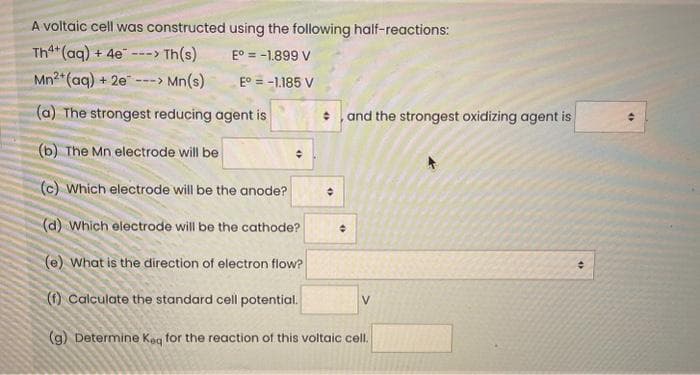A voltaic cell was constructed using the following half-reactions: Th4+ (aq) + 4e - ---> E° = -1.899 V Mn2+ (aq) + 2e- ---> E° = -1.185 V -> Th(s) Mn(s) (a) The strongest reducing agent is (b) The Mn electrode will be (c) Which electrode will be the anode? (d) Which electrode will be the cathode? (e) What is the direction of electron flow? (f) Calculate the standard cell potential. (g) Determine Keq for the reaction of this voltaic cell. ( + and the strongest oxidizing agent is V ● "
A voltaic cell was constructed using the following half-reactions: Th4+ (aq) + 4e - ---> E° = -1.899 V Mn2+ (aq) + 2e- ---> E° = -1.185 V -> Th(s) Mn(s) (a) The strongest reducing agent is (b) The Mn electrode will be (c) Which electrode will be the anode? (d) Which electrode will be the cathode? (e) What is the direction of electron flow? (f) Calculate the standard cell potential. (g) Determine Keq for the reaction of this voltaic cell. ( + and the strongest oxidizing agent is V ● "
Chemistry: Principles and Practice
3rd Edition
ISBN:9780534420123
Author:Daniel L. Reger, Scott R. Goode, David W. Ball, Edward Mercer
Publisher:Daniel L. Reger, Scott R. Goode, David W. Ball, Edward Mercer
Chapter18: Electrochemistry
Section: Chapter Questions
Problem 18.49QE: A half-cell that consists of a copper wire in a 1.00 M Cu(NO3)2 solution is connected by a salt...
Related questions
Question

Transcribed Image Text:A voltaic cell was constructed using the following half-reactions:
Th4+ (aq) + 4e
-> Th(s)
E° = -1.899 V
Mn2+ (aq) + 2e-
Mn(s)
E° = -1.185 V
(a) The strongest reducing agent is
(b) The Mn electrode will be
(c) Which electrode will be the anode?
(d) Which electrode will be the cathode?
(e) What is the direction of electron flow?
(f) Calculate the standard cell potential.
(g) Determine Keq for the reaction of this voltaic cell.
--->
✪
and the strongest oxidizing agent is
+
V
↑
Expert Solution
This question has been solved!
Explore an expertly crafted, step-by-step solution for a thorough understanding of key concepts.
This is a popular solution!
Trending now
This is a popular solution!
Step by step
Solved in 3 steps with 3 images

Knowledge Booster
Learn more about
Need a deep-dive on the concept behind this application? Look no further. Learn more about this topic, chemistry and related others by exploring similar questions and additional content below.Recommended textbooks for you

Chemistry: Principles and Practice
Chemistry
ISBN:
9780534420123
Author:
Daniel L. Reger, Scott R. Goode, David W. Ball, Edward Mercer
Publisher:
Cengage Learning

Principles of Modern Chemistry
Chemistry
ISBN:
9781305079113
Author:
David W. Oxtoby, H. Pat Gillis, Laurie J. Butler
Publisher:
Cengage Learning

Chemistry & Chemical Reactivity
Chemistry
ISBN:
9781337399074
Author:
John C. Kotz, Paul M. Treichel, John Townsend, David Treichel
Publisher:
Cengage Learning

Chemistry: Principles and Practice
Chemistry
ISBN:
9780534420123
Author:
Daniel L. Reger, Scott R. Goode, David W. Ball, Edward Mercer
Publisher:
Cengage Learning

Principles of Modern Chemistry
Chemistry
ISBN:
9781305079113
Author:
David W. Oxtoby, H. Pat Gillis, Laurie J. Butler
Publisher:
Cengage Learning

Chemistry & Chemical Reactivity
Chemistry
ISBN:
9781337399074
Author:
John C. Kotz, Paul M. Treichel, John Townsend, David Treichel
Publisher:
Cengage Learning


Chemistry: The Molecular Science
Chemistry
ISBN:
9781285199047
Author:
John W. Moore, Conrad L. Stanitski
Publisher:
Cengage Learning

Chemistry: Principles and Reactions
Chemistry
ISBN:
9781305079373
Author:
William L. Masterton, Cecile N. Hurley
Publisher:
Cengage Learning